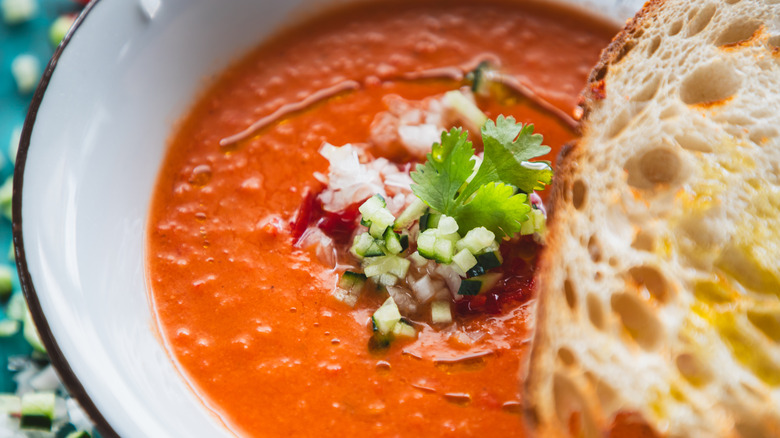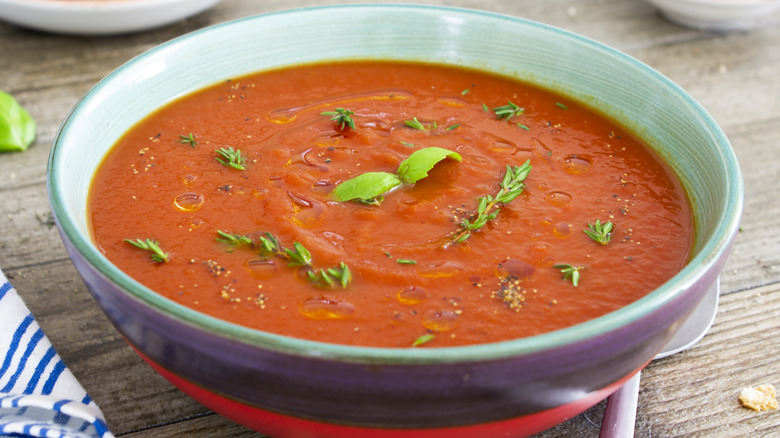Orange Juice Is The Secret Ingredient That Takes Tomato Soup To The Next Level
While that can of condensed soup might be an iconic pop culture image, building robust flavor in a bowl is more complicated than the layers of paint in that famous Andy Warhol image. Take tomato soup, for example. While tomato should always be the primary flavor here, in order to avoid that spoonful from becoming one note, a splash of orange juice can provide a sweet, bright boost to heighten the flavor experience.
Even though many cooks appreciate that citrus can offer a punch of acid, adding orange juice also provides a needed sugar boost. The concentrated sugar in the fruit juice adds a natural sweetness to the soup. Given that a well-balanced dish should have salty, sweet, bitter, sour, and umami flavors, the sweet component of the juice helps to round out the other savory flavors from the tomatoes. From amplifying the salt to counteracting the bitter, orange juice's sugar is the great harmonizer in a well-balanced tomato soup.
Although freshly squeezed orange juice might be preferred, store-bought options can work, as well. However, it is best to check the labels for any added sugars or beverages that are not 100 percent juice. This OJ ingredient hack is meant to be a sweetener, but no one wants to turn that comforting soup into a more densely caloric meal that feels like a dessert. Yes, the juice is worth the squeeze, but no one wants to drown the dish with a sugar bomb.
How much orange juice should you add?
Creating a well-balanced soup is more than a dash here and a sprinkle there. Beyond the long simmer, which makes for a more robust flavor, the overall viscosity of your soup is equally important. From a soup that coats the back of the spoon to a more fluid broth, the consistency is important to overall eating enjoyment. By adding orange juice, the tomato soup's liquid levels change. Even though a slow simmer will create some reduction, care should be taken when adding another liquid into the pot; it is best to consider the ratio of ingredients. When adding orange juice, you should be careful to pour in more than a splash but less than a cup. Remember, it is a tomato soup, not an orange soup, and nothing should overshadow the primary fruit.
In addition, the orange juice's consistency needs to be taken into consideration. Even though some people love that extra pulpy sip to start their day, that additional texture might be off-putting in a tomato soup. From cautiously juicing an orange to being thoughtful when choosing a store-bought juice, adding in some OJ should not be a mindless pour.
Balance out those flavors
While the orange juice helps to bring a touch of sweetness to tomato soup, the acidic notes add brightness to help balance the dish. Although tomatoes do have a similar flavor quality, the combination helps to keep the soup from becoming one note.
Generally, citrus works well with vegetables. Similar to squeezing a lemon on top right before presenting a plate, the addition of orange juice to tomato soup helps cut through the fat, balance the sweetness, or otherwise avoid a flat flavor. With tomato soup, the orange juice helps to create a bright bridge between the tomato and other ingredients. From rounding out the pungent garlic to keeping that drizzle of cream from overtaking the eating experience, the citrus helps to keep the scales from tipping too far in any one direction.
While tomato soup might seem like a simple, straightforward dish, the reality is that classic dishes contain a plethora of ingredients that need to be carefully balanced. Each ingredient provides more than just another flavor component — here, the vibrant liquid allows all the other flavors to shine brightly.


